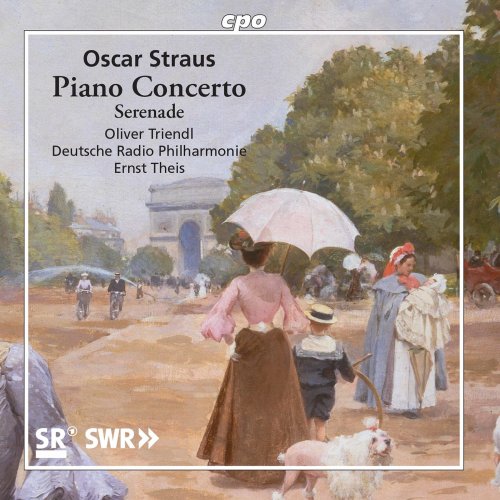
Oliver Triendl - Oscar Straus: Orchestral Works (2020)
BAND/ARTIST: Oliver Triendl, Ernst Theis, Deutsche Radio Philharmonie
- Title: Oscar Straus: Orchestral Works
- Year Of Release: 2020
- Label: cpo
- Genre: Classical
- Quality: FLAC (tracks+booklet)
- Total Time: 58:18
- Total Size: 280 MB
- WebSite: Album Preview
Tracklist:
1. Piano Concerto in B Minor: I. Moderato, ma non troppo lento - Allegro con brio (14:05)
2. Piano Concerto in B Minor: II. Lento assai (4:21)
3. Piano Concerto in B Minor: III. A tempo giusto (8:34)
4. Reigen-Walzer (Arr. Franz Marszalek) (4:08)
5. Serenade for String Orchestra in G Minor, Op. 35: I. Allegro commodo (5:48)
6. Serenade for String Orchestra in G Minor, Op. 35: II. Scherzino (3:01)
7. Serenade for String Orchestra in G Minor, Op. 35: III. Andantino (3:26)
8. Serenade for String Orchestra in G Minor, Op. 35: IV. Walzer (4:31)
9. Serenade for String Orchestra in G Minor, Op. 35: V. Alla marcia. Finale (4:04)
10. Tragant-Walzer nach Motiven des Tanzspiels "Die Prinzessin von Tragant": I. Einleitung. Andante (0:54)
11. Tragant-Walzer nach Motiven des Tanzspiels "Die Prinzessin von Tragant": II. Walzer Nr. 1 (1:09)
12. Tragant-Walzer nach Motiven des Tanzspiels "Die Prinzessin von Tragant": III. Walzer Nr. 2 (1:24)
13. Tragant-Walzer nach Motiven des Tanzspiels "Die Prinzessin von Tragant": IV. Walzer Nr. 3. Coda (3:00)
1. Piano Concerto in B Minor: I. Moderato, ma non troppo lento - Allegro con brio (14:05)
2. Piano Concerto in B Minor: II. Lento assai (4:21)
3. Piano Concerto in B Minor: III. A tempo giusto (8:34)
4. Reigen-Walzer (Arr. Franz Marszalek) (4:08)
5. Serenade for String Orchestra in G Minor, Op. 35: I. Allegro commodo (5:48)
6. Serenade for String Orchestra in G Minor, Op. 35: II. Scherzino (3:01)
7. Serenade for String Orchestra in G Minor, Op. 35: III. Andantino (3:26)
8. Serenade for String Orchestra in G Minor, Op. 35: IV. Walzer (4:31)
9. Serenade for String Orchestra in G Minor, Op. 35: V. Alla marcia. Finale (4:04)
10. Tragant-Walzer nach Motiven des Tanzspiels "Die Prinzessin von Tragant": I. Einleitung. Andante (0:54)
11. Tragant-Walzer nach Motiven des Tanzspiels "Die Prinzessin von Tragant": II. Walzer Nr. 1 (1:09)
12. Tragant-Walzer nach Motiven des Tanzspiels "Die Prinzessin von Tragant": III. Walzer Nr. 2 (1:24)
13. Tragant-Walzer nach Motiven des Tanzspiels "Die Prinzessin von Tragant": IV. Walzer Nr. 3. Coda (3:00)
Since Oscar Straus began his career in the cabaret, it was only natural for him to bet on comedy in his first operetta, Die lustigen Nibelungen (1904), a parody of the Nibelungenlied, Wagner, and Wilhelminism. In this way, Straus, more than any of his Viennese contemporaries, became the heir to Jacques Offenbach, the founder of the genre, whose last period of flourishing influenced Straus (who was born in 1870) as well as Franz Lehár, Leo Fall, and Emmerich Kálmán. Straus’s Serenade for String Orchestra is written in an always-radiant classical style. Especially the last two movements, “Walzer” and “Alla marcia,” have an elegant structure already anticipating the later operettas. The highly romantic Piano Concerto in B minor displays a very different compositional design. Even though the three movements based on Franz Liszt’s “New German” model form a seamless whole, they remain clearly recognizable and follow the pattern of the Classical-Romantic piano concerto, a form to which his teacher Max Bruch adhered until the very end. Oscar Straus’s claim that he was Bruch’s “favorite pupil” is made understandable by this romantic piano concerto, but he very much moves beyond his teacher, is bolder harmonically, and is more reminiscent of Liszt, whom Bruch rejected, along with his idea to have movements form sequences without breaks.
Download Link Isra.Cloud
Oliver Triendl - Oscar Straus_ Orchestral Works FLAC.rar - 280.7 MB
Oliver Triendl - Oscar Straus_ Orchestral Works FLAC.rar - 280.7 MB
Year 2020 | Classical | FLAC / APE
As a ISRA.CLOUD's PREMIUM member you will have the following benefits:
- Unlimited high speed downloads
- Download directly without waiting time
- Unlimited parallel downloads
- Support for download accelerators
- No advertising
- Resume broken downloads


